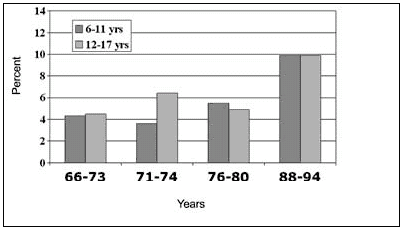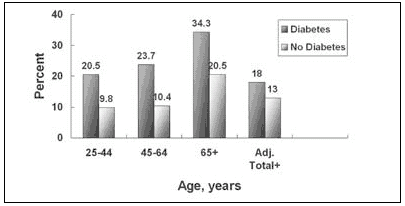National Agenda for Public Health Action:
A National Public Health Initiative on Diabetes and Women’s Health
Just the Facts
How does the burden of diabetes affect women?
Diabetes mellitus is a disease in which the body is unable to produce or properly use insulin-a hormone required to convert sugar, starches, and other food into energy. There are three main types of diabetes. Type 1 diabetes is a disease in which the body does not produce any insulin. This form occurs most often in children and young adults and accounts for 5%–10% of all cases of diabetes. People with type 1 diabetes must take daily insulin injections to stay alive. Type 2 diabetes is a metabolic disorder resulting from the body's inability to make enough, or to properly use, insulin. Type 2 diabetes is the most common form of the disease, accounting for 90%–95% of all cases of diabetes. Primary interventions involve a healthy diet and physical activity. A third type, gestational diabetes, is a form of glucose intolerance that is diagnosed in some women during pregnancy. Treatment is required to normalize maternal blood glucose levels and avoid complications for the infant. After pregnancy, 5%–10% of women with gestational diabetes are diagnosed with type 2 diabetes, and 20%–50% develop type 2 diabetes in the next 5-10 years.
Diabetes can be associated with serious complications and premature death. The burden of diabetes for women is unique because the disease can affect mothers and their unborn children. With the increasing life span of women, the rapid growth of minority racial and ethnic populations in the United States (who are hardest hit by the diabetes burden), and the recent increase in new cases of diabetes among younger women in their adolescent and teen years, the number of women at high risk for diabetes and its complications will continue to increase. These trends will impose heavy demands on the health care delivery system and other sectors of society. Although the cause of diabetes has not been identified, researchers have concluded that both genetic and environmental factors, such as obesity and lack of physical activity, play a major role. Lifestyle interventions designed to promote weight loss, increase physical activity, and improve diet can significantly reduce and delay the incidence of type 2 diabetes and are especially important for women at high risk for the disease. Because women are often influential in affecting behavior change in their own children and families, focusing prevention efforts on them is a good way to improve not only their health but also the health of those they love.
Diabetes Is a Serious and Growing Public Health Problem
- More than 17 million Americans currently have diabetes; 5.9 million of them are undiagnosed.
- One million new cases of diabetes are diagnosed each year.
- By the year 2050, the number of people with diagnosed diabetes is projected to increase from 11 million to 29 million.
- Diabetes costs the United States about $98 billion annually: $44 billion for direct medical care and $54 billion for indirect costs associated with disability, work loss, and premature mortality.
- People diagnosed with diabetes are at twice the risk of death as those without diabetes.
- Diabetes is the sixth leading cause of death and the primary cause of blindness, nontraumatic amputations of lower limbs, and kidney failure among adults.
Projected trends in prevalence of diagnosed diabetes among women, by age, 2000 to 2050
Projected trends in prevalence of diagnosed diabetes among women by age, 2000 to 2050

Source: Boyle JP, Honeycutt AA, Narayan KMV, Hoerger TJ, Geiss LS, Chen
H, Thompson TJ. Projection of diabetes burden through 2050. Diabetes
Care 2001;24:1936-40.
Note: A text version of this information
is available.
Diabetes has Unique and Profound Effects on Women
- More than 9.1 million women have diabetes.
- From 1990 to 1998, the prevalence of diabetes increased almost a third for both women and men.
- Women in minority racial and ethnic groups are the hardest hit by type 2 diabetes; the prevalence is two to four times higher among black, Hispanic, American Indian, and Asian-Pacific Islander women than among white women. Because minority populations are expected to grow at a faster rate than the U.S. population as a whole, the number of women in these groups who are diagnosed with diabetes will increase significantly in the coming years.
- Diabetes is a more common cause of coronary heart disease among women than men.
- Among people with diabetes, the prognosis of heart disease is worse for women than for men; women have poorer quality of life and lower survival rates than men do.
- The link between diabetes and obesity is striking. Nearly half (47%) the women with diabetes have a body mass index greater than 30 kg/m2 compared with 25% of all women.
Percent of women with annual household income <$25,000.

Adjusted for age, race/ethnicity, marital status, size of household, and
employment status
Source: BRFSS, 2000.
Note: A text version of this information
is available.
Diabetes Affects Women Differently at Various Life Stages
Adolescent Years (10–17 Years)
- About 86,192 females younger than 20 years old have type 1 diabetes; 92% are white, 4% are black, and 4% are Hispanic or Asian American.
- Eating disorders may be higher among young women with type 1 diabetes than among young women in the general population.
- There is an apparent increase in the number of youth of all racial and ethnic groups being diagnosed with type 2 diabetes, and it appears to be more common among girls than boys.
- By age 20 years, 40%–60% of people with type 1 diabetes have evidence of retinopathy, or diabetic eye disease. Untreated retinopathy can lead to blindness. The risk for developing proliferative retinopathy—the most severe form—is higher for girls than for boys (in at least one study).
Trends in Obesity Prevalence among Girls in the United States, 1966–1994

Source: Pediatrics, 1998
Note: A text version of this information
is available.
Reproductive Years (18–44 Years)
- An estimated 1.3 million women of reproductive age have diabetes; about 500,000 of them do not know they have the disease.
- Type 2 diabetes accounts for most diabetes cases during this life stage. Most women with type 1 diabetes were diagnosed during childhood or adolescence.
- Women of minority racial and ethnic groups are two to four times more likely than non-Hispanic white women to have type 2 diabetes.
- Reproductive-aged women with type 2 diabetes have fewer years of education, have lower income, and are less likely to be employed than women without diabetes.
- Estimates of the overall prevalence of gestational diabetes in the United States range from at least 2.5% to 4% of pregnancies that result in singleton live births, with higher percentages among some ethnic groups and older women. Most gestational diabetes occurs in women with risk factors for type 2 diabetes; they are unable to secrete sufficient insulin to overcome the increased insulin resistance that normally results as pregnancy proceeds.
- Gestational diabetes usually ends after the baby is born, but women with gestational diabetes have a 20%–50% chance of developing type 2 diabetes in the 5–10 years after childbirth.
- Children whose mothers had diabetes during their pregnancies have a greater likelihood of becoming obese during childhood and adolescence and of developing type 2 diabetes later in life.
Middle Years (45–64 Years)
- Approximately 3.8 million women aged 45–64 years have diabetes.
- Diabetes is a leading cause of death among middle-aged American women.
- Coronary heart disease is an important cause of illness among middle-aged women with diabetes; rates are three to seven times higher among women 45–64 years old with diabetes than among those without diabetes.
- In 2000, at least one in four women aged 45–64 years with diabetes had a low level of formal education, and one in three lived in a low-income household. Women with diabetes were more likely than women without diabetes to have a low socioeconomic status regardless of race, ethnicity, or living arrangements (marital status, size of household, and employment status).
Percent of women with less than high school education by age, diabetes status

Adjusted for age, race/ethnicity, marital status, size of household, and
employment status.
Source: BRFSS, 2000.
Note: A text version of this information
is available.
Older Years (65 Years and Older)
- About 4.0 million women aged 65 years and older have diabetes; one-quarter of them do not know they have the disease. Most elderly women with diabetes have type 2 diabetes.
- Because women make up a greater proportion of the elderly population and women with diabetes live longer than their male counterparts, elderly women with diabetes outnumber elderly men with diabetes. Diabetes is one of the leading underlying causes of death among women aged 65 years and older.
- Being older and having diabetes accelerate the development of diabetic complications such as heart disease, stroke, kidney disease, and blindness. Elderly women with diabetes are at particularly high risk for coronary heart disease, visual problems, hyperglycemia or hypoglycemia, and depression.
Factors That Place Women at Risk for Diabetes and Its Complications
Women face increasing risk of diabetes and its complications because of certain social, cultural, and economic trends. National surveys have indicated that since the 1970s there are increasing trends in the numbers of women who
- live in poverty (by age 65, women are twice as likely as men to be poor);
- work in small companies that provide fewer benefits and lower pay than larger companies, and face significant challenges to balance job and family responsibilities;
- are uninsured and/or lack access to health care (approximately one in seven women lack health insurance);
- are overweight and do not exercise regularly (about one-half of women aged 20 years or older are overweight, and more than one-quarter do not engage in regular physical activity).
What is the National Public Health Initiative on Diabetes and Women's Health?
As part of a comprehensive effort to improve women's health, CDC established the National Public Health Initiative on Diabetes and Women's Health. The initiative has three phases.
In Phase I, CDC prepared Diabetes & Women's Health Across the Life Stages: A Public Health Perspective. Published in 2001, this report examines the issues that make diabetes a serious public health problem for women; analyzes the epidemiologic, psychosocial, socioeconomic, and environmental dimensions of women and diabetes; and discusses the public health implications. This landmark document explores the impact of diabetes on women's lives by using a framework that defines the issues across various life stages—the adolescent, reproductive, middle, and elder years. A complete copy is available on CDC's Web site at http://www.cdc.gov/diabetes/projects/women.htm.
In Phase II, CDC joined forces with the American Diabetes Association (ADA), the American Public Health Association (APHA), and the Association of State and Territorial Health Officials (ASTHO) to convert the information contained in the 2001 report into action. Toward this end, the four cosponsoring agencies convened a task force in November 2001, with representatives of over 40 organizations from the public, private, and volunteer sectors. Proposed recommendations that emerged from this meeting were published as the Interim Report: Proposed Recommendations for Action and are also available on CDC's Web site.
In Phase III, the proposed recommendations contained in the interim report moved one step further. During a working summit meeting in August 2002, representatives from multidisciplinary agencies—including government, academic, voluntary, business, community-based, and professional organizations—selected recommendations of highest priority and identified appropriate strategies for implementation. This National Agenda represents the result of their deliberations for action.
Contact Us:
- CDC Diabetes Public Inquiries
- 800-CDC-INFO
(800-232-4636)
TTY: (888) 232-6348
8am-8pm ET
Monday-Friday
Closed Holidays - cdcinfo@cdc.gov


